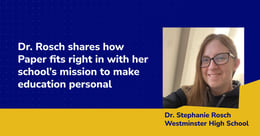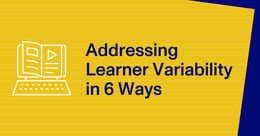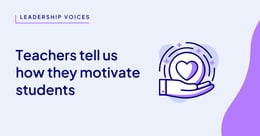Interested in learning more about how Paper can help build confidence in the classroom? Take a look at our video interviews with Ashley Bebow.

Building confidence: Ashley Bebow on Paper’s impact in her classroom
5 questions with Ashley Bebow
For Ashley Bebow, who teaches math at Hemlock Middle School—part of the Hemlock Public School District in Michigan—continuity is key.
In addition to helping students achieve exhilarating lightbulb moments when a new concept clicks, Bebow also draws inspiration from working with students across grade levels and helping them develop even deeper connections among topics. All in all, she maintains a positive atmosphere in the classroom to help learners build their confidence.
That doesn’t mean that the work is without its challenges. Bebow emphasizes perseverance and persistence, encouraging students to use their missteps as opportunities for growth.
We sat down with this dedicated teacher to learn more about how Paper is making a difference—for her and her students.
What are some of the challenges you’ve seen when students try to get help with math outside the classroom?
Before Paper, my students were using math apps where you can take a picture of something, and it shows you all your steps, but it doesn't necessarily explain to the kids what they're supposed to be doing.
Some students might try Google—typing in the whole problem to see what they can come up with.
Then, some of them would just give up. They'd think, “Well, I couldn't figure it out, so I'm just not going to do it.”
Having somebody to actually explain the math is a lot better than students using math apps or even trying to Google the problem. They don't always know what they're reading or if what they’ve found is even appropriate for the problems we're trying to solve.
How did introducing Paper to your students help balance that equation?
When I first introduced Paper to my students, I prefaced it by saying, “Hey, these are real people. Please don't waste their time.”
I had them use it during class—during an assignment—so that they could get comfortable with the interface. I was there to help as they were trying to figure out where to attach an assignment or how to find the whiteboard function.
In class, I had talked earlier about drawing a line through the equal sign to help see both sides of the equation. As they were working on the activity with a tutor, someone said, “Oh, they did the line strategy.” It's just nice to have tutors say the same things!
I have also had students say, “Hey, my Paper tutor yesterday was using a different strategy to solve this problem than the strategy we’re using in class.” This is actually a great opportunity to talk about how there are multiple ways to get to the same solution in math.
I think that's really nice for students to see, because sometimes they think what they’re doing is hard because there's only one way to get to the answer. Together with the Paper tutors, we can encourage students to see there are multiple strategies they can use to get an answer.
[READ: "Implementing tutoring in the classroom: 3 tips from a teacher"]
How does Paper help you ensure your students have 24/7 personalized support?
Before Paper, it was hard. My biggest classes have as many as 32 students. It's hard for me to get around—to see every one of my students while we're doing our independent practice.
Now, with the introduction of Paper, I can say, “If you don't feel like waiting for me, maybe you can log into Paper and connect with a tutor.” It's nice to see them taking that independence with their learning.
Paper has also cut down on the emails that I get at 10 o’clock at night. They're using the resource, and they're taking advantage of the fact that it's 24/7 help. I don't have nearly as many emails as I did.
How has being able to unplug helped with your well-being?
With the pandemic, we had to deal with that combination of virtual learning and in-person learning. It was a lot, and I struggled to keep up on both ends of it—I had to take care of my students that were here physically, but then I also had to take care of the ones that were virtual. I also had to keep track of all the assignments and make sure that I was providing enough help for everybody.
In my first couple years of teaching, I would be checking my email super late at night and then get stressed thinking I had to respond to all of it right away. I've definitely gotten better about that. I had to draw a line.
I have to go home and be able to recharge and get ready for the next day, because if I don't, then I'm not going to be the best version of myself for my students.
That’s important to me—coming in with a good mindset and a positive attitude—which students notice. I try to make sure that I set myself up for that success. I’m not saying that I don't get tired or burn out, but I just try to draw those lines.
[READ: "5 types of teacher well-being resources for your district"]
How is Paper helping your students succeed?
I have one student who was saying how he'll ask Mom or Dad for homework help, but they don't remember how to do the math. With Paper, the parents don't have to worry about trying to figure it out themselves. This student has grown so much with his confidence in math. He participates so much more in class.
When kids use it, they'll typically start with a question, and the tutor will ask, “OK, what do you think the next step is?” Then, they'll go through the next step. And then the tutor will say, “That's awesome! What's the next step after that?” The students will end up doing the whole problem themselves, but they have feedback each step of the way, building their confidence level.






.jpg?width=260&height=136&name=Educator-Voices-Laura-Ashley-Lavery%20(1).jpg)